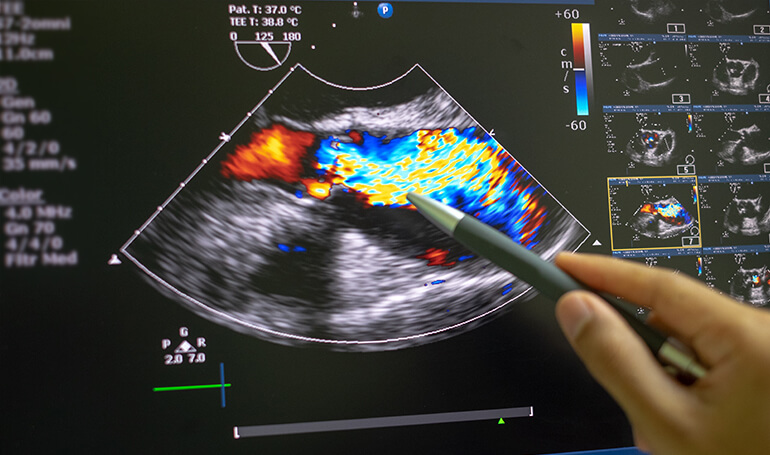Access to echocardiography represents the main current barrier to early detection of heart valve disease in the UK. One-third to two-thirds of outpatient echocardiography requests are made to investigate a murmur,1–3 and almost a fifth of cases have moderate or severe heart valve disease.3 In early 2022, 155,000 people were waiting for outpatient echocardiography in the UK,4 with up to 91,450 likely to have a murmur, and up to 16,461 likely to have moderate or severe heart valve disease. Delayed diagnosis causes delay in management with potential negative consequences on patient outcome. Consequently, the British Heart Valve Society (BHVS) recommends easy access to echocardiography for patients with suspected heart valve disease; it also recommends that echocardiography departments have a system of alerts for detected significant heart valve disease.

Capacity increase is imminently needed to meet the current demand. An immediate increase in workforce to increase capacity is not realistic, because of the national shortage of cardiac physiologists and the time needed to appropriately train them in echocardiography. Thus, the BHVS proposed an increase in capacity by reducing the time used for echocardiography when a comprehensive study is not needed. The complete description of the proposal is available on the BHVS website (https://bhvs.org/bhvs-management-of-echocardiography-requests/).
The BHVS proposes the use of four levels of echocardiography: basic (level 1), focused, minimum standard, and disease specific. To ensure safety and efficiency of the assessment, all four levels of echocardiography, including basic and focused, should be performed by accredited and highly experienced echocardiographers. A basic (level 1) study may suffice to exclude pathology, or it may confirm the need for further assessment. A focused study may be used to answer a clinical question; it may be used to detect change in patients having had previous minimum-standard studies, for example in specialist valve clinics at follow-up. A minimum-standard study is needed if the basic study identifies pathology. Additional disease-specific image acquisition and measurements may be needed to complement a minimum-standard study for the assessment of heart valve disease.
Furthermore, the BHVS proposes triage of outpatient and inpatient echocardiography requests, prioritising studies in need of urgent assessment, assigning the appropriate level of echocardiography, and rejecting requests that lack a robust indication.
Outpatient echocardiography requests

Outpatient echocardiography requests for murmurs should be prioritised depending on the severity of symptoms. In case of critical symptoms, like syncope or chest pain on exertion, and new-onset or severe breathlessness, an urgent appointment should be offered, ideally in a specialist heart valve clinic within two weeks. All symptomatic patients should be assessed as soon as possible, not later than in six weeks. In the absence of symptoms, murmurs should be assessed with an initial basic (level 1) study, to detect or exclude pathology.
Echocardiography is not indicated in native heart valve disease at shorter than recommended intervals in the absence of clinical change. It is also not indicated for regular follow-up of mechanical valves, or biological valves, for at least five years following implantation.
In a specialist valve clinic providing one-stop echocardiography, focused echocardiography can be used to answer a specific clinical question posed by the cardiologist. For example, focused echocardiography may be used to detect haemodynamic consequences of asymptomatic severe heart valve disease that indicate intervention, such as, for instance, a drop in ejection fraction of the left ventricle. Focused echocardiography may also be used to detect progression of previously mild heart valve disease in need of a minimum-standard study.
Minimum-standard echocardiography is indicated for the serial assessment of significant heart valve disease at a guideline-compliant time interval; the study can be complemented by disease-specific echocardiography.
Inpatient echocardiography requests
For inpatient requests, the need for echocardiography, the level of echocardiography and the clinical urgency, should be discussed with the clinician in charge, and with the patient. For example, echocardiography is needed if infective endocarditis is likely based on clinical presentation and blood test results, but it should not be used indiscriminately as a fever screen.
Basic (level 1) echocardiography can be used for the assessment of an incidental murmur in patients admitted for a different indication; this study may have to be performed as an emergency, if diagnosis of heart valve disease could change management. Basic (level 1) echocardiography can be used to detect or exclude pericardial effusion following valve intervention and to inform the need for life-saving treatment in the acutely unwell patient.
Focused echocardiography can be performed before discharge after cardiac surgery to detect pathology in need of immediate management, for example pericardial effusion, left ventricular dysfunction or dysfunction of a prosthetic valve.
Minimum-standard echocardiography is always needed in patients with known heart valve disease admitted with heart failure, and in patients with a murmur developed after acute myocardial infarction. Urgent echocardiography is recommended in unexplained heart failure or cardiogenic shock, to exclude heart valve disease as a cause.
Conflicts of interest
The author of this editorial is the current President of the British Heart Valve Society.
Funding
None.
References
1. Chambers JB, Kabir S, Cajeat E. The detection of heart disease by open access echocardiography: a retrospective analysis. Br J Gen Prac 2014;64:86–7. https://doi.org/10.3399/bjgp14X677167
2. Van Heur LMSG, Baur LHB, Tent M et al. Evaluation of an open access echocardiography service in the Netherlands: a mixed methods study of indications, outcomes, patient management and trends. BMC Health Serv Res 2010;10:37. https://doi.org/10.1186/1472-6963-10-37
3. Mahadevan VS, Earley M, McClements B. Open access echocardiography has diagnostic yield similar to outpatient echocardiography and is highly rated by general practitioners and patients. Int J Cardiol 2005;99:389–93. https://doi.org/10.1016/j.ijcard.2004.01.042
4. Punshon G, Leary A. A survey of the echocardiography workforce in the UK. London: British Society of Echocardiography, February 2022. Available from: https://www.bsecho.org/common/Uploaded%20files/Membership/Workforce/BSE-Echocardiography-workforce-survey-report.pdf
